Over a period of of more than 5,000 years, evidence suggests a ritual of human reincarnation was held at 12 megalithic temples around the world with a direct alignment to the rising sun on the winter solstice. The sacred sites share striking similarities, suggesting the ritual practice dates back much further, possibly to an unknown civilization.
Atop a high hill overlooking a sharp bend in the River Boyne in County Meath, Ireland, the rising sun on the winter solstice shines into the entrance of a megalithic mound, travels 60 feet down a passage and enters a domed chamber 17 feet across and more than 20 feet high.
Built 5,200 years ago, the egg-shaped mound at Brú na Bóinne is about the size of a football field and decorated with tons of polished white quartz. Known as Newgrange, the mound is supported by a massive stone structure filled with soil and thousands of smooth, egg-shaped river cobbles imported to the site. Directly across the river, archaeologists have identified a large natural landform that likely served as an amphitheater.
Large crowds once gathered from December 17-24 to enjoy music, food and beverages and to celebrate the sun stopping its southward descent on the horizon and turning north again, promising another spring. The dates align exactly with the Ursid meteor showers, providing a Neolithic fireworks show. But there may have been another compelling item on the agenda, another reason for people to come from 100 miles around in mid-winter to attend the week-long festivities.
Cross-cultural evidence shows the mound at Brú na Bóinne was the oldest of 12 sacred sites around the world to be designed as the backdrop for a ritual celebration of the reincarnation of human souls at dawn on the winter solstice. In the ancient world, it was widely believed that souls could inhabit stone, and the egg-shaped megalithic forms at all 12 megaliths may have played the role of incubators, where souls were rejuvenated and protected inside a sacred refuge. When the newborn sun finally touched the stones at dawn on the solstice, the souls were quickened to start a new life.
The design of most sites produced acoustic effects to enhance the sound of music, chanting or drumming during the longest night of the year, perhaps to help awaken the sun and the souls of the dead. The Great Circle of 36 standing stones erected at Brú na Bóinne would have produced acoustic sound effects – only 12 stones remain in place today. Certainly, the stone chambers inside megalithic mounds produced unique sound effects.
Mid-winter baby boom
Other crucial players in the dramatic scene at dawn on the winter solstice were numerous newborn infants and pregnant women near full-term, ready to act as receptacles for the reincarnated souls.
The winter solstice came about nine months after spring planting season when ancient farming cultures ritually celebrated and publicly encouraged sexual intercourse to invoke the universal power of fertility. Springtime sex was ritually celebrated by the Sumerians – the first farming culture – and later in ancient Egypt, Greece, Rome, and throughout Europe. Cross-cultural myths suggest intercourse in the newly turned fields and during rainstorms was common.
“In primal myths of the Neolithic era … soil was female and seed was the embryo formed by sky and rain, the sexual intercourse of sky and earth,” according to a 2016 study in the Journal of Reproduction and Infertility. “Ritual sex relationships during crop cultivation were customary … (and) could revive the fertilizing power of the soil.”
For pregnant women nearing full-term in December, the act of walking to the closest sacred site for the winter solstice, along with the rhythms of music and drumming, may have encouraged the onset of labor. During the week of December 17-24, dozens of infants may have been born in the chambers of numerous smaller mounds scattered across the 2,000-acre Brú na Bóinne site along the Boyne River. The chambers were easily sealed and may have functioned as saunas with stable temperatures to support the birth process and the health of newborns.
“The problem of controlling and maintaining temperatures to ensure the viability of a newborn infant is a critical factor in the negotiation of birth,” according to “Birthing in pre-history,” a study in the June 2004 edition of the Journal of Anthropological Archaeology.
The dramatic celebration of souls reincarnating into newborns and pregnant women was embedded in a core concept of the nature religions: As above, so below, a maxim etched in the legendary Emerald Tablet by the Greek god Hermes, believed to derive his wisdom from the Egyptian god Thoth. When the sun was reborn in the heavens on the winter solstice, souls were reborn at sacred sites on earth: As above, so below.
Solstice sites built on avian wintering grounds
Genetic studies suggest the original builders of Brú na Bóinne were dark-skinned farmers from Anatolia in southwest Turkey who settled in a valley made especially verdant by wintering whooper swans leaving their droppings for untold millennia. The siting of the temple on avian seasonal grounds was no coincidence.
Every solstice-aligned site in the archaeological record was built on the winter grounds of migratory birds, including some of the largest and most diverse avian populations in the world. Every site featured prominent egg-shaped forms that were likely perceived as nests for souls to incubate before beginning their next life. Decorated or embalmed bird eggs, egg-shaped pottery, and bird imagery can be found in burials across dozens of ancient and indigenous cultures. One of the most common cross-cultural beliefs was that migratory birds carried the souls of the dead to a place of rest and rejuvenation.
Cross-cultural myths suggest music, dancing, and poetry were an integral part of winter solstice rituals. In a 3,000-year-old Vedic hymn, the Hindu sun goddess Usas was hidden in a cave on an island in a river at the end of the world, so the god Indra journeyed to the cave with a troupe of poets and singers and broke through the entrance so the first dawn could light the world. When the Japanese sun goddess Amaterasu hid herself in a cave in December, the other gods came after her and built fires outside the cave, bringing roosters of the Eternal Land that crowed continuously. One of the gods danced on an oval platform and laughed so hard that everyone laughed.
A variety of methods were used to attract birds to the sacred sites, including shallow pools, fruit trees, placing fresh mollusks on altars, and playing bird-calls on whistles or flutes made from the wing bones of vultures, eagles, or swans. On the winter solstice, the astrologers, diviners and seers in attendance would have been busy predicting the future of newborns blessed by the reborn sun. Releasing birds to observe their flight was a common form of divining the future, and was probably practiced on the solstice.
‘Masters of Rebirth’ at Brú na Bóinne
When whooper swans left Iceland in late fall to fly southeast across the North Atlantic, the ancient Icelanders believed the swans carried the souls of the dead with them. Today, the whoopers still migrate to England and Ireland, including the River Boyne in County Meath. Their complex vocalizations were described in Irish myth as soothing and healing to the soul.
Brú na Bóinne was the home of the Tuatha Dé Danann (Tribe of Danu), who identified with musical whooper swans in mythic tales and were known as “masters of rebirth” in the Irish countryside into the early 20th century. Among the distinguished members of the Danann tribe was Tuan MacCarell, who was said to have survived Noah’s flood by reincarnating as a salmon, and then lived dozens more lifetimes before relating the history of Ireland to St. Patrick. It should be noted that Atlantic salmon still spawn in the tidal River Boyne in midwinter, including the winter solstice.
The 10th century Dindsenchas reports that Brú na Bóinne was the birthplace of Cermait, son of the Danann chief Dagda and his consort Boann, the Milky Way goddess who created the River Boyne. “Behold the two paps of his consort, here beyond the mound, west of the fairy mansion, where Cermait was born, behold it there, not a far step.”
When the Tuatha Dé Danann were ultimately defeated by the invading Milesians from Spain, they agreed to surrender and disappear into the spirit world under the mounds and the waters. But an Irish legend recounted in the 1912 book, The Fairy Faith in Celtic Countries, suggests the Danann agreed to become spirits as part of a plan to reincarnate themselves in the bellies of the Milesian princesses, a neat metaphysical trick that would have returned them to power. The book was authored by W.Y. Evans-Wentz, a college classmate and longtime friend of the poet W. B. Yeats.
The ovoid towers of Angkor Wat

Angkor Wat temple, photo Andrew Lih (CCBYSA2.0)
Tonle Sap Lake in Cambodia is one of the largest wintering grounds for migratory birds in Southeast Asia. Just a few miles away, the ovoid conical towers at Angkor Wat represent the mythical Mount Meru, where Hindu souls are reincarnated. The stone walls are sculpted with musicians playing double-headed drums, hourglass drums, barrel drums, horns, gongs, chimes, cymbals, and conch shells. A wide canal forms a rectangle around the temple, attracting thousands of birds.
On the walls of the temple is painted the mythical Garuda bird, who discusses the metaphysics of reincarnation in the Garuda Purana. A small temple on a nearby hill was the designated viewpoint for watching the winter solstice sun rise over the towers.
The Buddha-Egg of Maharashtra
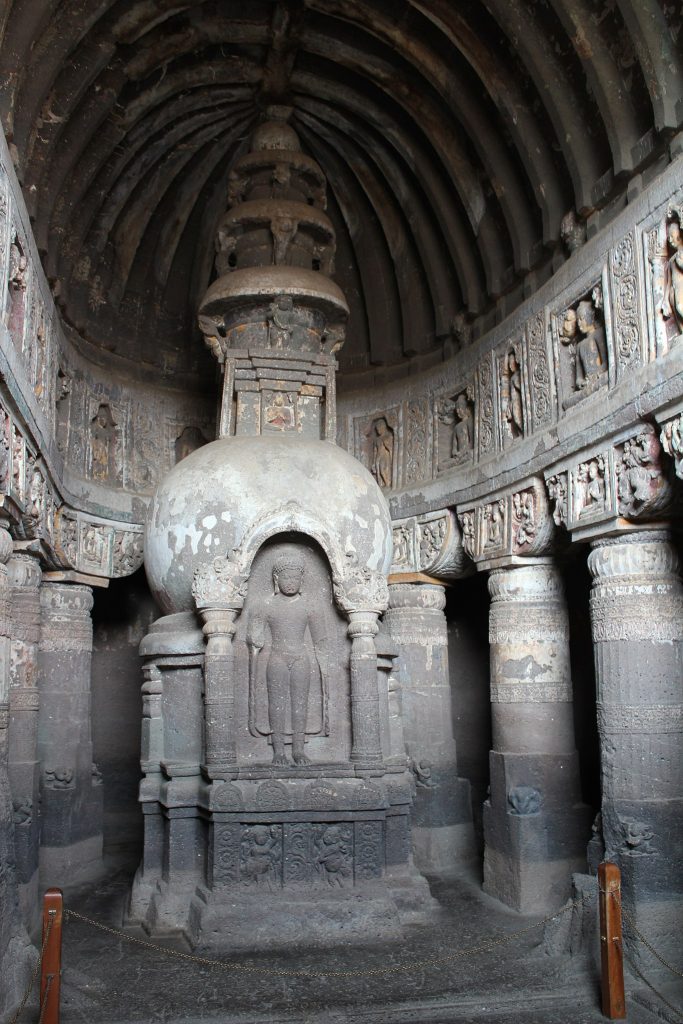
Ajanta, cave 19, photo Arian Zwegers (CCBYSA2.0)
About 2,100 years ago in Maharashtra, India, the Ajanta Caves were dug out from a massive U-shaped rock face near the Jaikwadi Bird Sanctuary, a winter ground for about 30 species of migratory birds. On the winter solstice, the rising sun shines on a standing Buddha in Cave 19, who appears to be emerging from a white egg of polished stone. The caves were built only a few centuries after the Buddha’s death.
Stonehenge and Durrington Wells
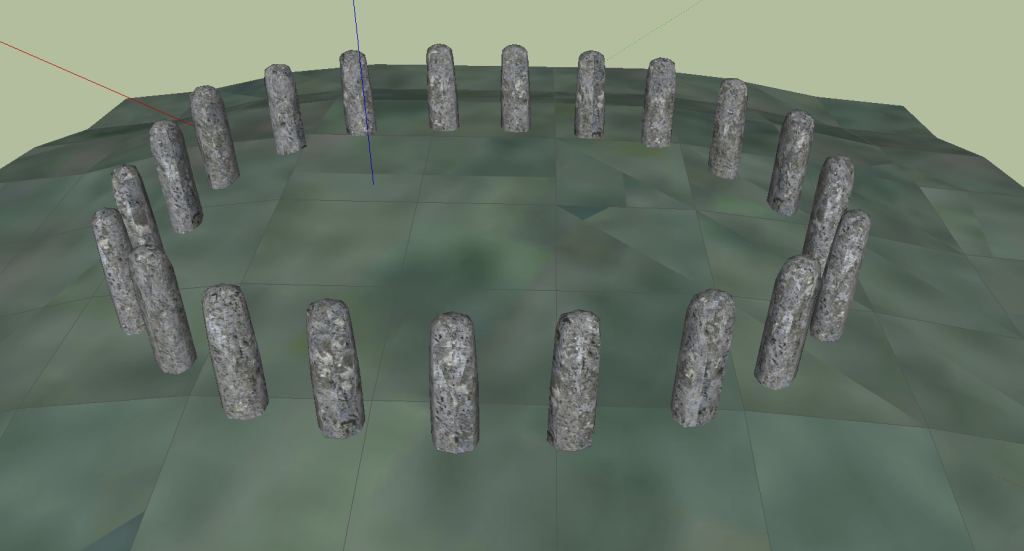
A digital reconstruction of Bluestonehenge, by Henry Rothwell (CCBYSA3.0)
Located on a bird route on the East Atlantic Flyway, Stonehenge was built 4,500 years ago with a primary alignment to the winter solstice. After an oval ring of standing bluestones was erected at Stonehenge, percussive drumming would have created a resonating acoustic effect, which recent studies have shown has a relaxing influence on brainwaves.
Less than two miles east at a bend in the Avon River is Durrington Walls, once a large settlement contained inside an oval henge measuring 1,700 feet by 1,475 feet, built about a century before Stonehenge. The long axis of the oval ring is exactly perpendicular to the southeast horizon, where the sun rises on the winter solstice. The village also had its own astronomical observatory known as a Woodhenge, consisting of an oval ring the size of a football field once encircled by wooden posts 26-feet tall.
The Kastelli Giant’s Church
Built by hunter-gatherers across northwest Finland between 5,500 and 4,000 years ago, Giant’s Churches were ovate and aligned to the solstices and equinoxes by doorways and the long/short axis. The acoustic effects inside the churches would have been unique. Among the largest ovals is Kastelli Giant’s Church, at 197 feet on the long axis and 115 feet on the short axis. Only short stone walls in a grassy field are left to mark the outline of the church today.
Victory over death in Portugal
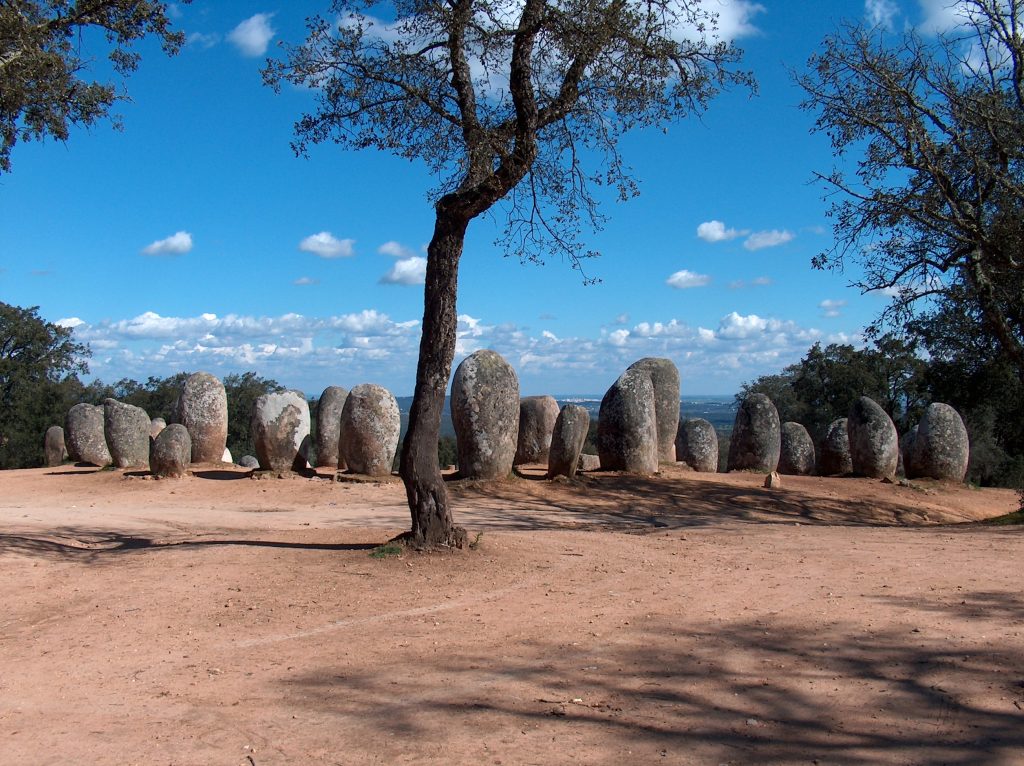
Almendres Cromlech, photo João Carvalho (PD)
The stone oval ring known as Almendres Cromlech was built about 6,000 years ago near Evora, Portugal. It measures 230 feet on the long axis and 130 feet across, featuring 95 oval/almond-shaped stones up to 11 feet tall. Any ring of large standing stones creates acoustic effects. Evora is one of three almond-growing regions in Portugal.
In Greek and Persian myths, the almond tree was associated with rebirth, reawakening, and victory over death, perhaps because almond trees bloom in February and March. A single standing stone almost 15 feet tall and three feet in diameter was found about a mile from the oval ring, forming a visual alignment with the rising sun on the winter solstice.
The ‘Sleeping Lady’ of Malta
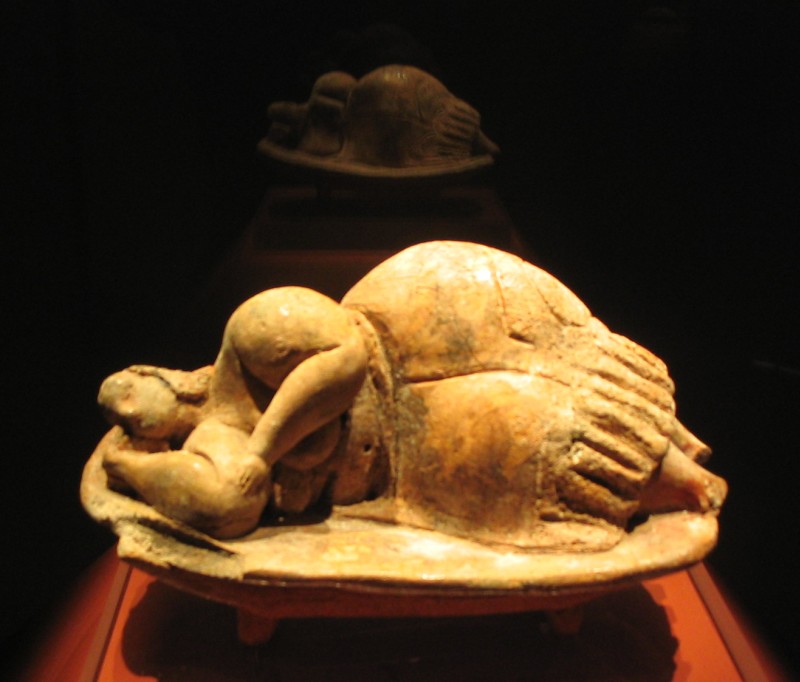
Sleeping Lady, photo Stefan H (PD)
A three-level underground tomb known as the Hypogeum was built about 6,000 years ago on the island of Malta, a popular rest stop for migratory birds flying between Italy and Africa on the Mediterranean-Black Sea Flyway. The tomb complex stayed in use for 1,200 years and contained the remains of about 7,000 people.
Most of the stone rooms across the three levels of the Hypogeum are egg-shaped, and the overall design allowed sunlight to penetrate into the second level at dawn on the winter solstice. One of the most compelling features of the second level is a sculpted mother goddess known as the Sleeping Lady, whose body is made of oval shapes, including legs, arms, and head. A voice speaking at about 110 hertz into a small oval niche in the Oracle Room produces an eerie echo that radiates throughout the structure.
The Sun Temple of Odisha
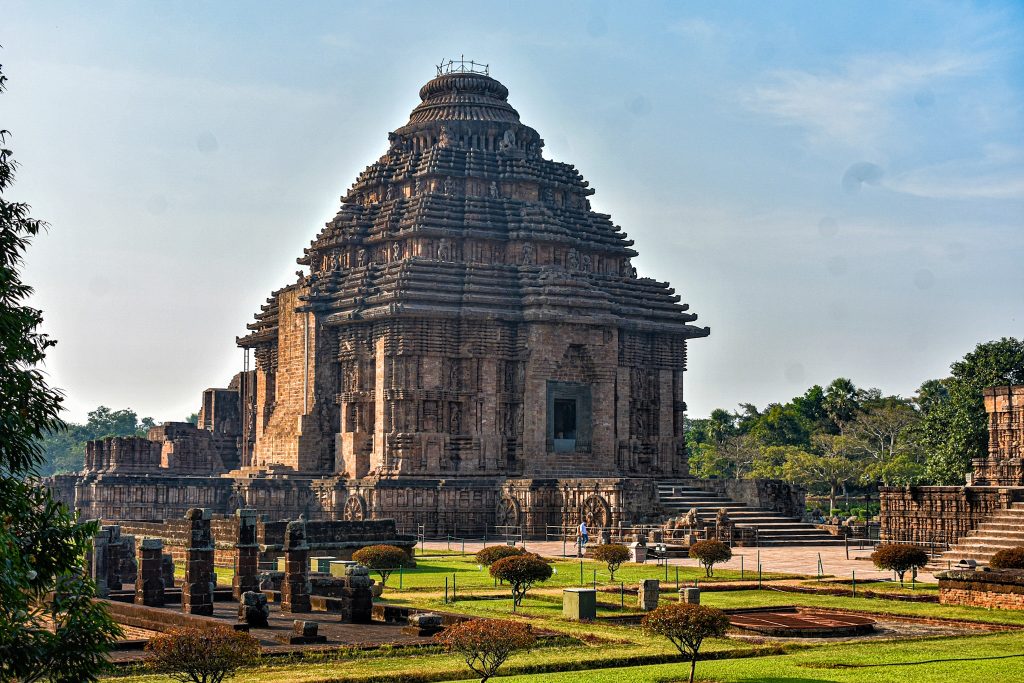
Konarka Temple, photo Subham9423 (CCBYSA4.0)
On the Bay of Bengal in northeastern India’s State of Odisha is the shallow but enormous Lake Chilika, the biggest wintering ground for migratory birds on the Indian subcontinent. Nearby is the Sun Temple at Konârak, built about 700 years ago and aligned to the winter solstice. The temple features a dancing hall and sculpted musicians playing drums, flutes, lyres, and cymbals.
After shining down a long pathway between various structures, the winter solstice sun enters a pyramidal/ovoid structure and into the inner sanctum where it once illuminated a green chlorite statue of the sun god Surya, embedded with gems.
Birds and serpents in Ohio
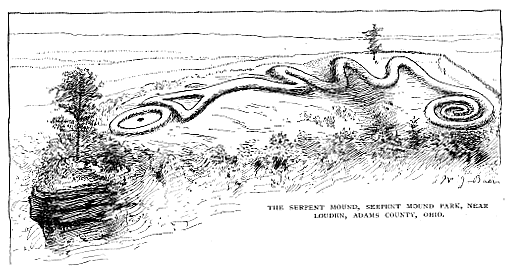
Serpent Mound (PD)
The Great Serpent Mound in southeast Ohio was likely built at least 2,000 years ago by the Adena culture, which believed in a mythic Thunderbird that ruled the sky and a great serpent that governed the earthly realm. The snaking mound was built high on a ridge above a serpentine creek in a region where two global bird migration flyways converge in a narrow corridor below the Great Lakes.
The serpent is 1,300 feet long and three feet tall, with its mouth stretching around an egg-shaped mound. Various curves of the serpent are aligned to the solstices and equinoxes. The mound may have been what scholars call a “magico-religious schema” to engage with a sacred raptor, encouraging it to descend from the sky and battle the giant serpent with its mouth around an egg.
The solstice-aligned mounds of Cahokia
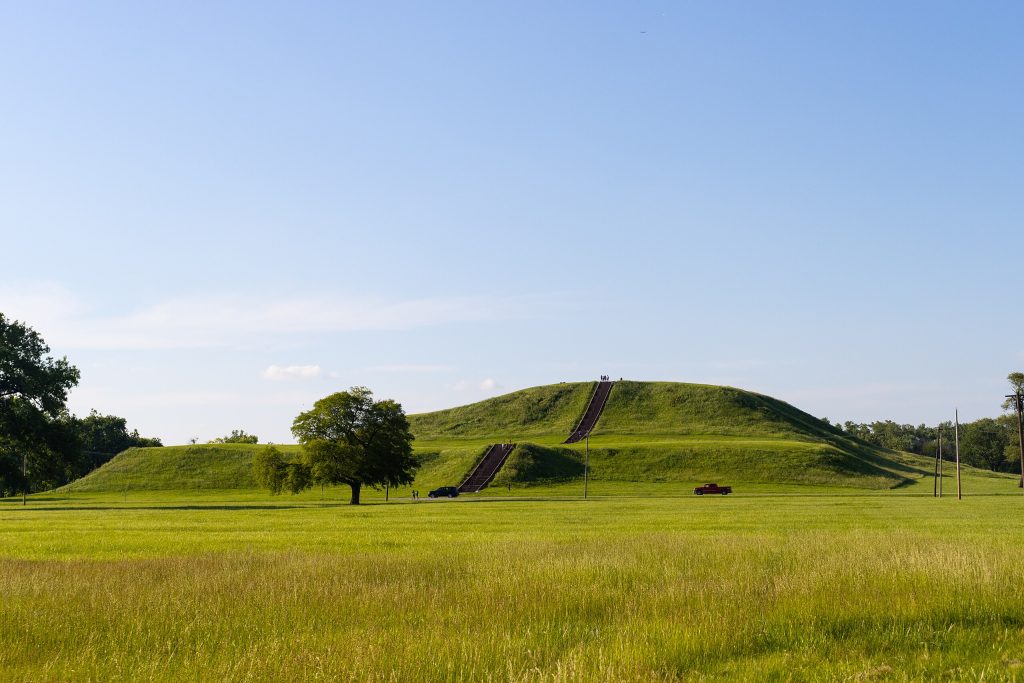
Monks Mound, photo Skubasteve834 (CCBYSA4.0)
About 1,300 years ago, a small city specializing in maize production emerged on the Mississippi River just east of St. Louis. Given the name Cahokia by archaeologists, the urban trading center consisted of 120 large earthen mounds with a population of 20,000 or more. It was a place of seasonal feasts where the sacred theater of music and dance was likely performed on the flattened tops of mounds aligned to both solstices.
At the center of the city was a mound with an ovate base 1,000-feet long and 800 feet wide, standing 100 feet tall. Now known as Monk’s Mound, it was created from layers of past structures, buried ancestors, and fill. From above, the earth-worked edges of one end appear to be shaped like the tail feathers of a bird. Hundreds of small clay tablets were found in the area showing a bird-man “falcon dancer.” Cahokia is just north of a modern-day trumpeter swan wintering ground, which may have been larger and could have encompassed the city when the first mounds were built.
The recent excavation of two solstice-aligned mounds suggest that birds played a central role in rituals. Archaeologists found that 434 swans buried in Mound 34 were not eaten, but many of the wing bones were used to make beads and awls. Twenty-five bird species were found inside Mound 51, including bald eagles, red-tailed hawks, peregrine falcons, herons, pelicans, egrets, ravens, parakeets, woodpeckers and 13 kinds of ducks. Very few species of birds buried in the mound were part of the indigenous diet, again suggesting the burials were part of a religious ritual.
The oval village of Chankillo
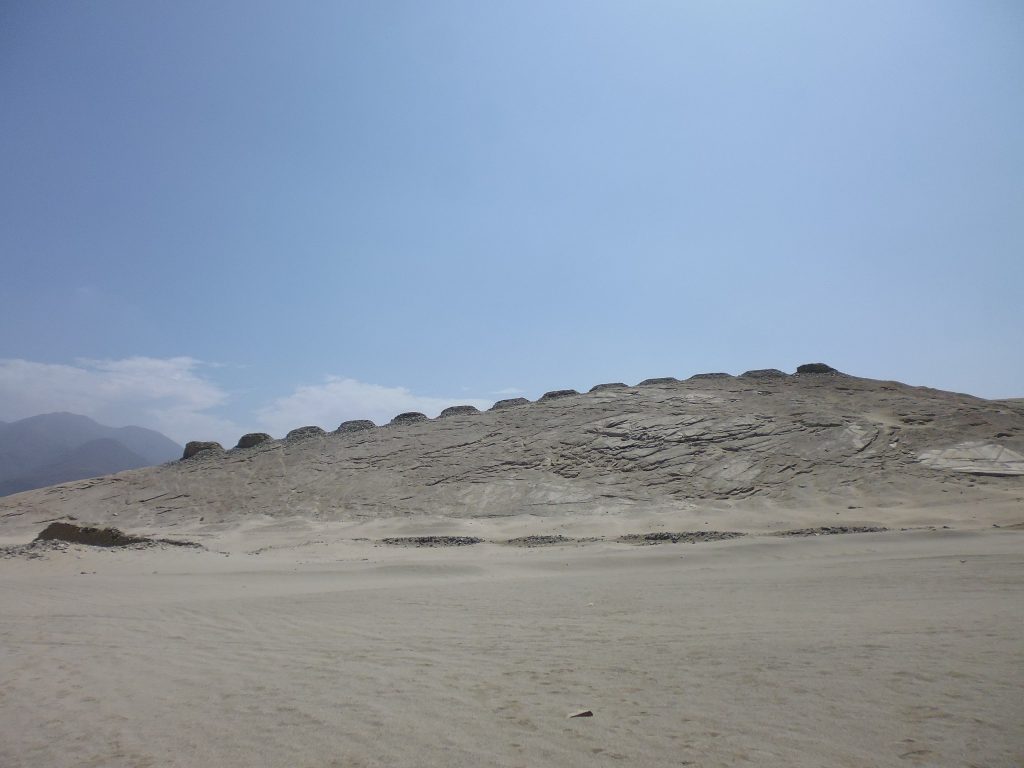
Torres de Chankillo, photo Juancito28 (CCBYSA4.0)
Located where a route of the Pacific Americas Flyway makes landfall on the coast of northern Peru, the boundary line of the 2,400-year-old village of Chankillo was an oval stone ring with concentric walls; small houses surrounded a civic plaza and stone temple. Above the village on a north-south running ridge are the Thirteen Towers of Chankillo, with the north end aligned to the summer solstice and the south end to the winter solstice.
The Great Zimbabwe Ruins
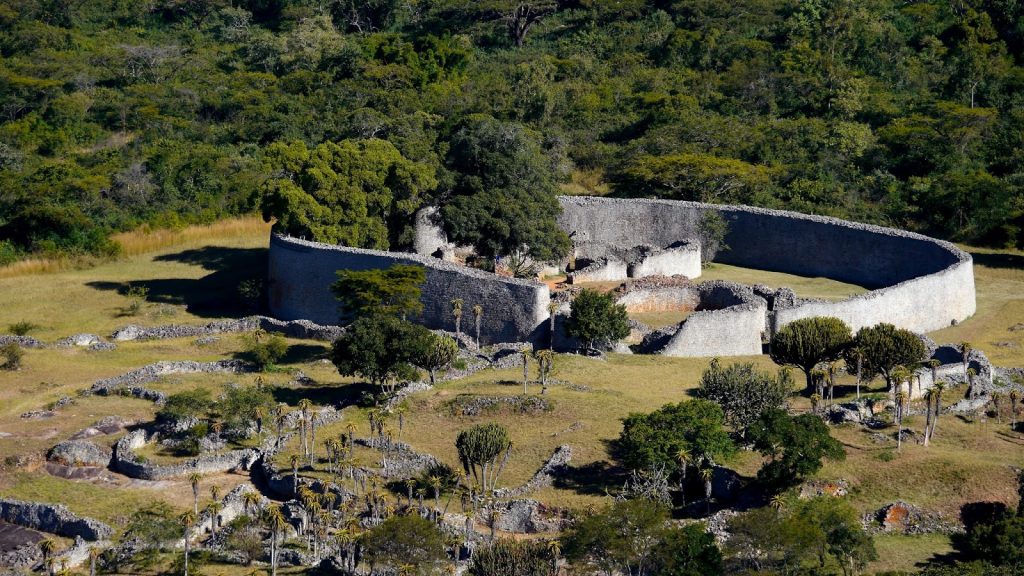
The Great Zimbabwe Ruins, photo Simonchihanga (CCBYSA4.0)
Believed to have been built about 800 years ago by an unknown Bantu-speaking people, the main feature of the Great Zimbabwe Ruins is the egg-shaped Great Enclosure, surrounded by granite walls 32 feet high that would have created unique acoustic effects.
It’s the largest prehistoric stone structure south of the Sahara, located near the rare convergence of three global bird flyways. In a 2002 study, Richard Wade of the Nkwe Ridge Observatory in South Africa found that the three bright stars of Orion rise over three standing stone pillars on the morning of the winter solstice.
The sacred theater of the solstice
The evidence paints a picture of pregnant women, newborns, healers, diviners, musicians, dancers and cooks joining thousands more at megalithic sites aligned to the winter solstice to participate in both the rebirth of the sun and the metaphysical process of reincarnation.
Long before the advent of Judaism, Christianity, and Islam, it appears there was a near-universal belief that sex, pregnancy, birth and reincarnation were inextricably tied to the ritual calendar, culminating on the winter solstice, when gods and cultural heroes were said to be born.
These were miraculous events taking place against dramatic backdrops with unique acoustic effects, producing a form of sacred theater that brought the entire community into the phases and cycles of life. The ritualized celebration was like a play performed on a stage, perhaps telling the origin story of ancient cultures.
The Koguryo of North Korea describe a river goddess shut away in a dark room until the rays of the sun cause her to conceive and give birth to an egg that hatched the first Koguryo king. Similar solstice myths are found in Japan, India, and Iran.
Just after the winter solstice, the Egyptian Milky Way goddess Net gave birth to Osiris, Isis, Nephthys, Seth, and Horus the Falcon, according to the Greek historian Plutarch. The pagan god Mithra was said to be born on the winter solstice. The storied birth of Jesus Christ occurs under the North Star on December 25.
When founding the Roman Empire, the first emperor Caesar Augustus successfully re-branded himself by associating with the astrological sign Capricorn and the miraculous regenerative power of the winter solstice. Although Caesar was a Libra, he made new coins with himself on one side and the December sign of Capricorn on the other. He also established six new towns with their main streets laid out as processionary paths for the sun on the winter solstice, including the town of Aosta.
The ritual of seasonal births may be much older than farming cultures. For hunter-gatherers, it would have been a common-sense adaptation for women to give birth while the group was least active, holed up in the middle of winter. With many animals hibernating and vegetation mostly dormant, there was enough spare time and energy to help mothers through the birthing process and keep the infants healthy. When spring rolled around, and the group became more active, the infants would be mature enough to manage.
While the concept of reincarnation has long been in the rear view mirror of Western civilization, it appears to be making a comeback. As church attendance continues to decline across the Western world, younger generations are more ready to accept the concept of reincarnation. While just 27 percent of American adults over 50 believe in the concept, the ratio grows to almost 4 in 10 (38 percent) among adults under 50, according to a recent poll by the Pew Research Center.
Psychiatrist Ian Stevenson of the University of Virginia conducted more than 2,500 case studies on reincarnation over 40 years and published 12 books, including Twenty Cases Suggestive of Reincarnation. Stevenson documented each child’s statements and then identified the deceased person the child identified with, and verified the facts of the deceased person’s life that matched the child’s memory. He also matched birthmarks and birth defects to wounds and scars on the deceased, verified by medical records such as autopsy photographs in Reincarnation and Biology.
The word reincarnation is derived from the Latin “to take on the flesh again” and appears in the philosophical traditions of ancient Greece dating back 2,600 years. While the global religions of Judaism, Christianity and Islam don’t believe in reincarnation, it is a core principle of Hinduism, Buddhism, Jainism, Australian Aborigines, numerous nature-based indigenous religions, Neopaganism, Spiritism and Astara.
The Bhagavad Gita states: “Never was there a time when I did not exist, nor you, nor all these kings; nor in the future shall any of us cease to be. As the embodied soul continuously passes, in this body, from childhood to youth to old age, the soul similarly passes into another body at death. A sober person is not bewildered by such a change …”
Ben H. Gagnon is an award-winning journalist and author of Church of Birds: an eco-history of myth and religion (Collective Ink, 2023).






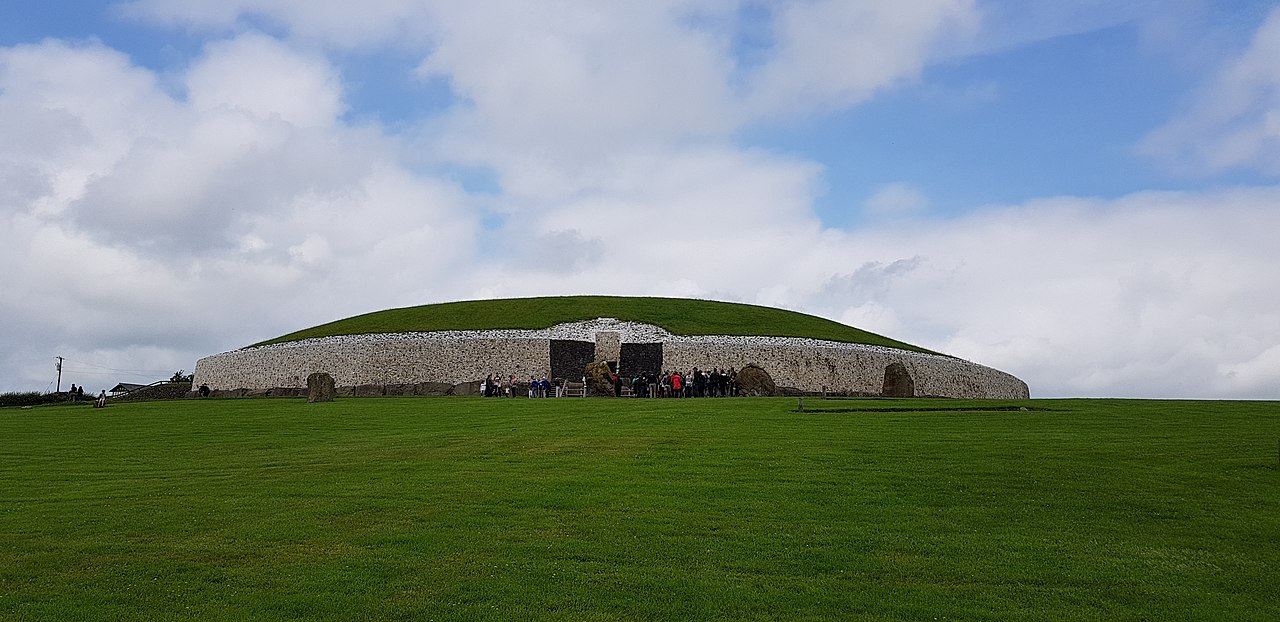
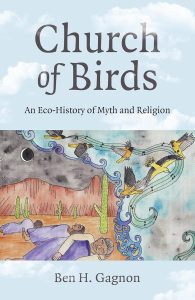
Outstanding article Ben. Thank you!
Love this.
Wow, what an amazing information…thank you
Very interesting. One bit that caught my eye was
‘The ritual of seasonal births may be much older than farming cultures. For hunter-gatherers, it would have been a common-sense adaptation for women to give birth while the group was least active, holed up in the middle of winter.’
I suspect that common-sense adaptation, that is, the reuse of processes etc that have shown to be effective over time, might apply to other life and cultural aspects of life. The progression of moves from the various early stone tools all the way to the use of an alphabet seem to reflect something such as this.
Enjoyed the Church of Birds.
Dr.Ambedkar zeroed in on the Triguna-based Chatur-Varna rationale of Gita:
Negatively, I reject the Hindu social philosophy propounded in the Bhagavad Geeta based as it is, on the Triguna of the Sankhya philosophy which is in my judgment a cruel perversion of the philosophy of Kapila and which had made the caste system and the system of graded inequality the law of Hindu social life. https://swarajyamag.com/longform/dr-ambedkar-dr-elst-and-bhagavad-gita
The Yamnaya culture highly stratified caste system held power in few top elites wiped out many hunter gatherers.The Yamnaya culture is an ancestral component of the Vedic period, and is thought to have contributed to the Indo-European languages spoken in Europe and Asia.
And just look at how it is today….
The evidence for the resurrection of Jesus is much stronger than evidence for reincarnation. Man tries to prepare for the next life in many ways. Jesus claims He is the way. Other religions offer many paths to God. Jesus offers one way – no one gets to the Father without Him.
We are all responsible to search for the evidence and decide which path to follow, the broad one most people take, or the narrow one that only few people find.
All the “studies” on reincarnation prove is that people can get information from the spiritual realm including contact with the dead. Christianity has always acknowledged this and puts forth an explanation for how and why this happens.
An interesting point for reflection. Speaking as a woman, on first reading this comes across as a patriarchal society, where men would be telling women, and young couples, when is a good time to conceive, when to make love. Or perhaps times with a much warmer climate during winter. Interestingly enough, when I have consciously aligned myself with the winter solstice as a time of the rebirth of the sun, I have conceived not long after the winter solstice. Practically speaking, I would think the last thing you would want as a woman is to give birth in the middle of winter, but rather when the weather is consistently warm for a good 6 months.
Fascinating article, but you missed one important winter solstice alignment at Karahan Tepe c.9400 BC which has egg-shaped enclosures. Many of the ideas you mention here are in our article: https://grahamhancock.com/newmanainsworth2/
Great article.
I’ve heard of a celtic myth of pregnant women encouraged to sleep in temples with deceased relatives to encourage their spirits to move to the unborn child